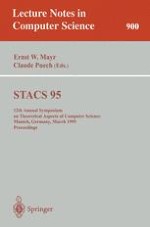1995 | Book
STACS 95
12th Annual Symposium on Theoretical Aspects of Computer Science Munich, Germany, March 2–4, 1995 Proceedings
Editors: Ernst W. Mayr, Claude Puech
Publisher: Springer Berlin Heidelberg
Book Series : Lecture Notes in Computer Science
Included in: Professional Book Archive
